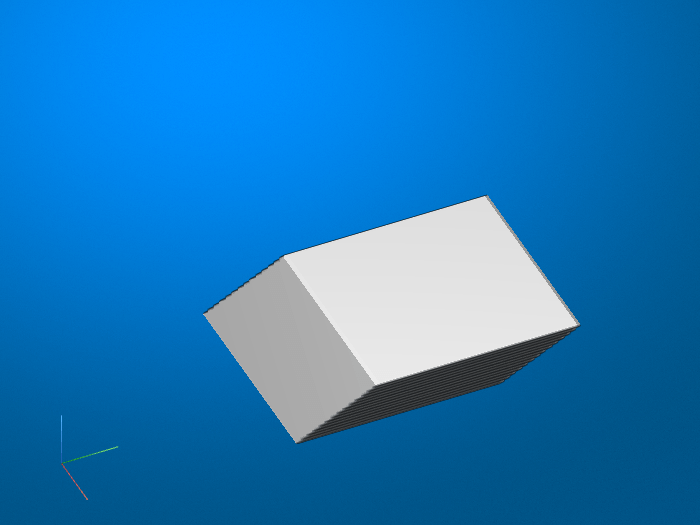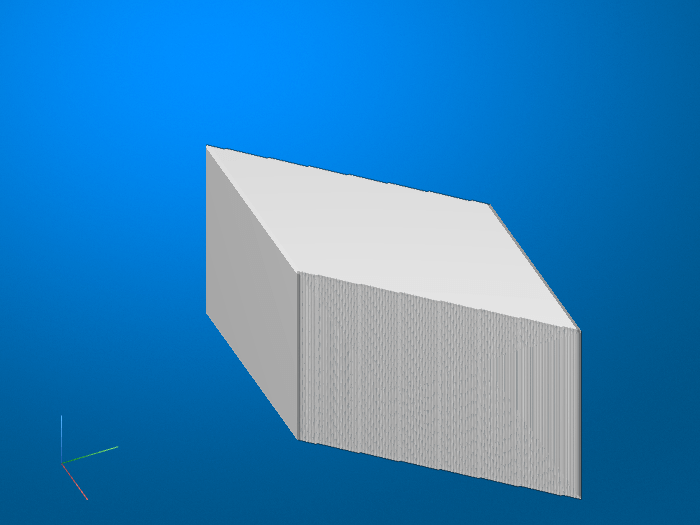randomAffine3d
Create randomized 3-D affine transformation
Description
tform = randomAffine3daffinetform3d
object that performs an identity transformation.
tform = randomAffine3d(Name,Value)
Examples
Create a sample volume.
volumeCube = 0.5*ones(100,100,100);
Create a 3-D viewer to control the appearance of the scene. Set the camera position of the scene to improve the visibility of the volume.
viewer = viewer3d(CameraPosition=[700 -250 650],CameraTarget=[50 50 50]);
Display the volume in the scene.
volshow(volumeCube,Parent=viewer);

Create a 3-D affine transformation that shears 3-D volumes. The randomAffine3d function picks a shear amount randomly from a continuous uniform distribution within the interval [40, 60] degrees. randomAffine3d picks a random shear direction aligned with the x-, y-, or z-axis.
tform1 = randomAffine3d(Shear=[40 60]); J1 = imwarp(volumeCube,tform1);
Display the sheared volume in a new scene with the same camera position.
viewer1 = viewer3d(CameraPosition=[700 -250 650],CameraTarget=[50 50 50]); volshow(J1,Parent=viewer1);

To shear a volume by a different randomly selected amount, create a new 3-D affine transformation. Note the difference in the shear direction.
tform2 = randomAffine3d(Shear=[40 60]); J2 = imwarp(volumeCube,tform2);
Display the sheared volume in a new scene with the same camera position.
viewer2 = viewer3d(CameraPosition=[700 -250 650],CameraTarget=[50 50 50]); volshow(J2,Parent=viewer2);

Name-Value Arguments
Specify optional pairs of arguments as
Name1=Value1,...,NameN=ValueN, where Name is
the argument name and Value is the corresponding value.
Name-value arguments must appear after other arguments, but the order of the
pairs does not matter.
Example: tform = randomAffine3d(XReflection=true)
Before R2021a, use commas to separate each name and value, and enclose
Name in quotes.
Example: tform = randomAffine3d("XReflection",true)
Random horizontal reflection, specified as false or
true. When XReflection is
true (1), the transformation
tform reflects images horizontally with 50% probability. By
default, the transformation does not reflect images in the horizontal
direction.
Random vertical reflection, specified as false or
true. When YReflection is
true (1), the transformation
tform reflects images vertically with 50% probability. By
default, the transformation does not reflect images in the vertical direction.
Random reflection along the depth direction, specified as false
or true. When ZReflection is
true (1), the transformation
tform reflects images along the depth direction with 50%
probability. By default, the transformation does not reflect images in the depth
direction.
Range of rotation applied to the input image, specified as one of the following. Rotation is measured in degrees.
A 2-element numeric vector. The second element must be larger than or equal to the first element.
randomAffine3dpicks a rotation angle randomly from a continuous uniform distribution within the specified interval.randomAffine3dselects a random axis of rotation from the unit sphere.A function handle of the form
The function[rotationAxis,theta] = selectRotation
selectRotationmust accept no input arguments. The function must return two output arguments:rotationAxis, a 3-element vector defining the axis of rotation, andtheta, a rotation angle in degrees.Use a function handle to pick rotation angles from a disjoint interval or using a nonuniform probability distribution. You can also use a function handle to specify an axis of rotation. For more information about function handles, see Create Function Handle.
By default, the transformation tform does not rotate
images.
Example: [-45 45]
Range of uniform (isotropic) scaling applied to the input image, specified as one of the following.
A 2-element numeric vector. The second element must be larger than or equal to the first element. The scale factor is picked randomly from a continuous uniform distribution within the specified interval.
A function handle. The function must accept no input arguments and return the scale factor as a numeric scalar. Use a function handle to pick scale factors from a disjoint interval or using a nonuniform probability distribution. For more information about function handles, see Create Function Handle.
By default, the transformation tform does not scale
images.
Example: [0.5 4]
Range of shear applied to the input image, specified as one of the following. Shear is measured as an angle in degrees, and is in the range (–90, 90).
A 2-element numeric vector. The second element must be larger than or equal to the first element. The shear angle is picked randomly from a continuous uniform distribution within the specified interval.
randomAffine3dapplies shear with uniform randomness to one of the principle x-, y-, and z-directions with respect to one of the two possible orthogonal directions.A function handle. The function must accept no input arguments and return the shear angle as a numeric scalar. Use a function handle to pick a shear angle from a disjoint interval or using a nonuniform probability distribution. For more information about function handles, see Create Function Handle.
By default, the transformation tform does not shear images in
the horizontal direction.
Example: [0 45]
Range of horizontal translation applied to the input image, specified as one of the following. Translation distance is measured in pixels.
A 2-element numeric vector. The second element must be larger than or equal to the first element. The translation distance is picked randomly from a continuous uniform distribution within the specified interval.
A function handle. The function must accept no input arguments and return the translation distance as a numeric scalar. Use a function handle to pick a translation distance from a disjoint interval or using a nonuniform probability distribution. For more information about function handles, see Create Function Handle.
By default, the transformation tform does not translate
images in the horizontal direction.
Example: [-5 5]
Range of vertical translation applied to the input image, specified as one of the following. Translation distance is measured in pixels.
A 2-element numeric vector. The second element must be larger than or equal to the first element. The translation distance is picked randomly from a continuous uniform distribution within the specified interval.
A function handle. The function must accept no input arguments and return the translation distance as a numeric scalar. Use a function handle to pick a translation distance from a disjoint interval or using a nonuniform probability distribution. For more information about function handles, see Create Function Handle.
By default, the transformation tform does not translate
images in the vertical direction.
Example: [-5 5]
Range of translation along the depth direction applied to the input image, specified as one of the following. Translation distance is measured in pixels.
A 2-element numeric vector. The second element must be larger than or equal to the first element. The translation distance is picked randomly from a continuous uniform distribution within the specified interval.
A function handle. The function must accept no input arguments and return the translation distance as a numeric scalar. Use a function handle to pick a translation distance from a disjoint interval or using a nonuniform probability distribution. For more information about function handles, see Create Function Handle.
By default, the transformation tform does not translate
images in the depth direction.
Example: [-5 5]
Output Arguments
Affine transformation, returned as an affinetform3d
object.
Version History
Introduced in R2019bStarting in R2022b, most Image Processing Toolbox™ functions create and perform geometric transformations using the premultiply
convention. Accordingly, the randomAffine3d function now returns the
output argument tform as an affinetform3d
object, which supports the premultiply convention. Before, the function returned
tform as an affine3d object, which supports the
postmultiply convention. For more information, see Migrate Geometric Transformations to Premultiply Convention.
See Also
imwarp | randomCropWindow3d | centerCropWindow3d
Topics
- Augment Images for Deep Learning Workflows (Deep Learning Toolbox)
MATLAB Command
You clicked a link that corresponds to this MATLAB command:
Run the command by entering it in the MATLAB Command Window. Web browsers do not support MATLAB commands.
Select a Web Site
Choose a web site to get translated content where available and see local events and offers. Based on your location, we recommend that you select: .
You can also select a web site from the following list
How to Get Best Site Performance
Select the China site (in Chinese or English) for best site performance. Other MathWorks country sites are not optimized for visits from your location.
Americas
- América Latina (Español)
- Canada (English)
- United States (English)
Europe
- Belgium (English)
- Denmark (English)
- Deutschland (Deutsch)
- España (Español)
- Finland (English)
- France (Français)
- Ireland (English)
- Italia (Italiano)
- Luxembourg (English)
- Netherlands (English)
- Norway (English)
- Österreich (Deutsch)
- Portugal (English)
- Sweden (English)
- Switzerland
- United Kingdom (English)